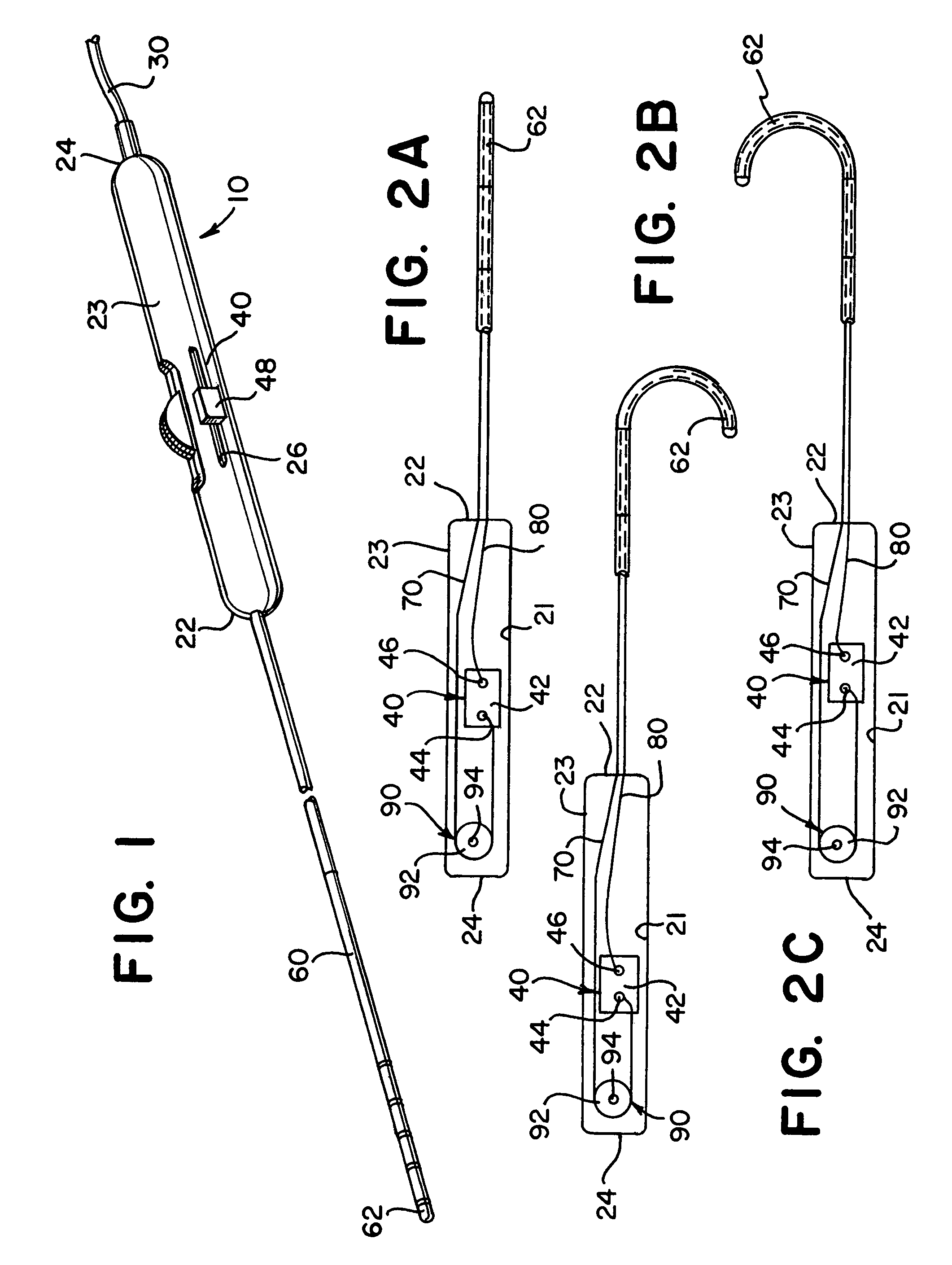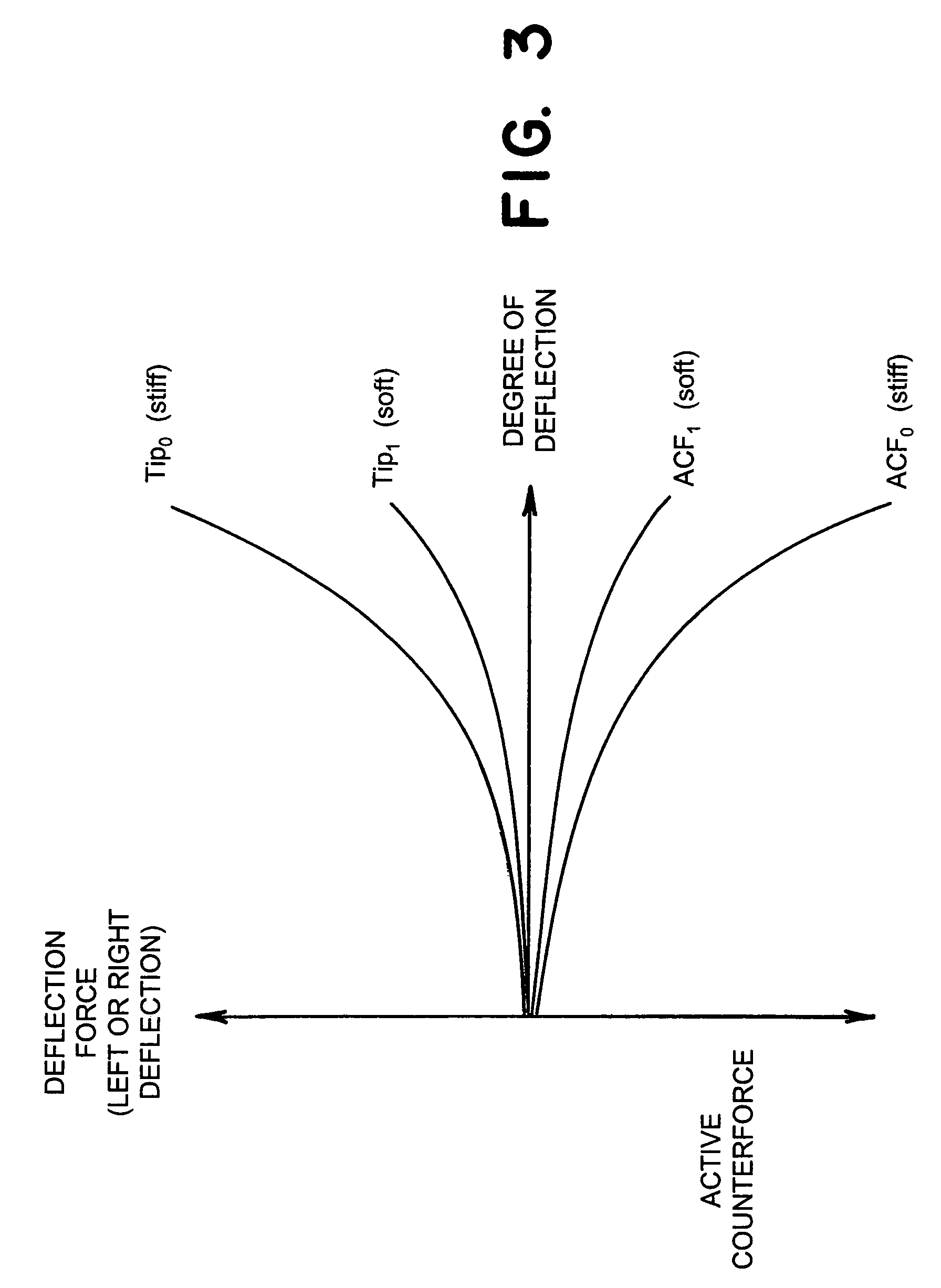Active counterforce handle for use in bidirectional deflectable tip instruments
- Summary
- Abstract
- Description
- Claims
- Application Information
AI Technical Summary
Benefits of technology
Problems solved by technology
Method used
Image
Examples
first embodiment
[0033]Now referring to FIGS. 1 and 4A-4C. In accordance with one preferred embodiment of the invention, the active counterforce attributes of the handle 20 are provided by integrating the active counterforce mechanism 50 into the handle 20 in operative combination with the control mechanism 40. FIGS. 4A-4C show the active bidirectional counterforce mechanism 50 according to a Generally, the active bidirectional counterforce mechanism 50 is designed to provide a force to counter the return to center force generated by the catheter shaft 60 as the catheter shaft 60 is deflected in either the first or second directions. This will accordingly assist the user in deflecting the distal end 62 of the catheter shaft 60 over the deflection range of the distal end 62. Optimally, the active counterforce mechanism 50 exactly balances the return to center force from the catheter shaft 60 across its range of motion in the first and second directions resulting in the user experiencing minimal resi...
second embodiment
[0046]Now referring to FIG. 5 in which an active counterforce mechanism is illustrated and generally indicated at 200. The active counterforce mechanism 200 functions generally in the same way as the counterforce mechanism 50 in that it provides a counterforce which balances the return to center force generated by the catheter shaft 60 (FIG. 1). The active counterforce mechanism 200 includes a main traverse bar 210, a first cross bar 220, a second cross bar 230 and a biasing element 240. In FIG. 5, the active counterforce mechanism 200 is shown in a neutral position by solid lines and is shown in proximal and distal positions by phantom lines.
[0047]The main traverse bar 210 has a distal end 212 and an opposing proximal end 214 with the distal end 212 being connected to the slider 42. The proximal end 214 is pivotally connected to the first and second cross bars 220, 230 at a pivot joint 250. More specifically, the first cross bar 220 comprises a lower cross bar and includes a first...
third embodiment
[0053]Now referring to FIG. 6 in which an active counterforce mechanism is generally illustrated and indicated at 300. The active counterforce mechanism 300 is disposed within the compartment 21 of the handle 20 and as in the previously-described embodiments, the mechanism 300 provides a force to counter the catheter force generated by the catheter shaft 60 (FIG. 1) during deflection thereof. The counterforce mechanism 300 includes a traverse bar 310, a biasing element 320, first and second roller bars 330, 340, and first and second rollers 350, 360.
[0054]More specifically, the traverse bar 310 has a distal end 312 connected to the slider 42 and an opposing proximal end 314 connected to the biasing element 320.
[0055]The traverse bar 310 generally extends longitudinally within the compartment 21 of the handle 20. In the illustrated embodiment, the biasing element 320 comprises a torsion spring. The torsion spring 320 has a coiled portion 322 and a pair of linear arms 324, 326 extend...
PUM
 Login to View More
Login to View More Abstract
Description
Claims
Application Information
 Login to View More
Login to View More - R&D
- Intellectual Property
- Life Sciences
- Materials
- Tech Scout
- Unparalleled Data Quality
- Higher Quality Content
- 60% Fewer Hallucinations
Browse by: Latest US Patents, China's latest patents, Technical Efficacy Thesaurus, Application Domain, Technology Topic, Popular Technical Reports.
© 2025 PatSnap. All rights reserved.Legal|Privacy policy|Modern Slavery Act Transparency Statement|Sitemap|About US| Contact US: help@patsnap.com



